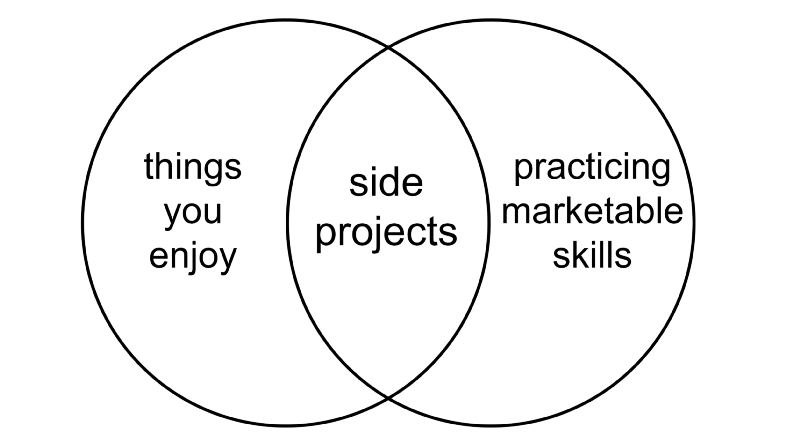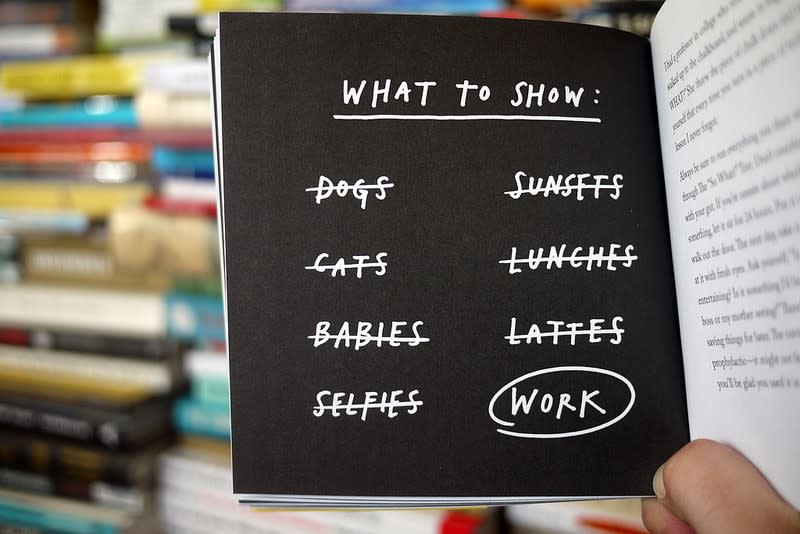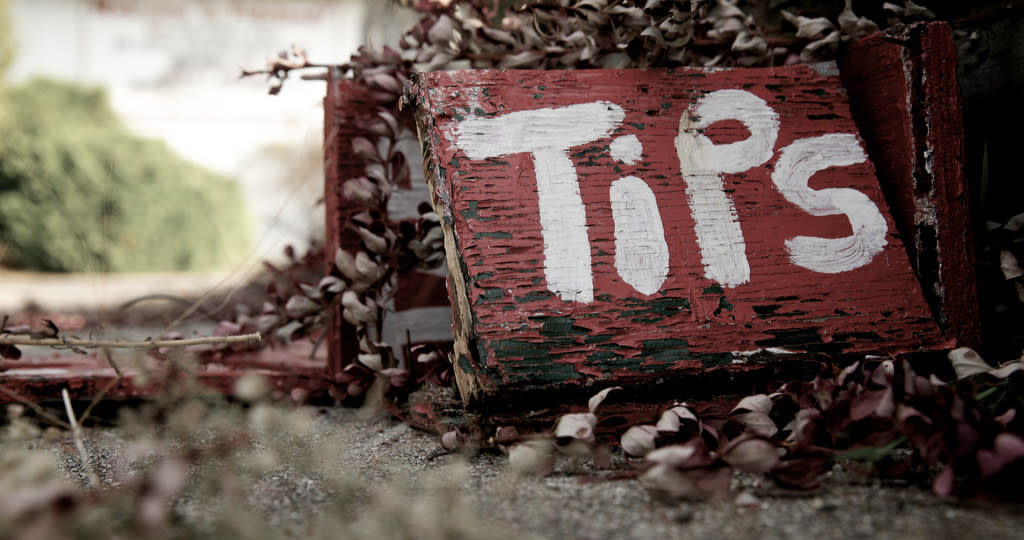For businesses, giving resources and time to side projects has proven over and over to be worth it. Slack, everyone’s favorite communication hub, started life as a simple tool for a group of game developers. Instagram was founded when the creators of Burbn, a location-based app for whiskey lovers, realized their users were sharing photos of more than just their cocktails. And Twitter, of course, was a silly little project spawned out of podcasting platform Odeo.
But what about for you? I’m sure you have some big, crazy ideas that have been sitting in the back of your mental closet for months, if not years. What if these side project ideas aren’t so "crazy" after all?
Side projects help us uncover new interests, promote divergent thinking (one of the building blocks of creativity), and can potentially take your life in an unexpected direction. However, that's also what makes them scary. They require time and money—and more importantly, you'll need enough motivation from the meaning the side project brings to keep going when it's tough.
So what makes a personal side project successful? After reading the stories of 10 creators, from a programmer-turned-author to a college kid who just inked a book deal based on his dog rating side project, I found these 7 common "ingredients" for starting, building, and launching a successful personal side project.
1. Find Something That Sits Between "Things You Enjoy" and "Skills You Want to Build"
It’s no surprise that side projects should be something you enjoy and find meaning in as well as can help you professionally. As Julie Zhou, product design VP at Facebook and avid side project champion explains, "Side projects work best when they live at the interaction of ‘Things you enjoy’ and ‘Things that help you practice a marketable skill.’"

While this is simple in theory, it can quickly get murky. Start a side project solely because it will help you get ahead in your own job and you run the risk of that project becoming just an extension of your work. Rather than feeling motivated to spend time on it, you'll approach it just like another task on your work to-do list.
However, if your project doesn’t help you build a skill you can use in other parts of your life, you’re just having fun. Which is fine, of course. But won’t necessarily bring in a level of meaning to your life.
The goal then, as Zhou explains, is to find that sweet spot in the middle.
A good litmus test is that side projects are typically productive, not consumptive. That’s not to say side projects have to be 100% focused on production.
For example, you may be interested in building an app, but not (yet) have the technical skills to do it. So step 1 would be to take an online course on app development. Then, throughout the course, you could work on the app, knowing it will take a while, but always with that goal keeping you motivated.
2. Treat Your Side Projects as Experiments

The hard thing about side projects is that there’s a lot more of us in them than in our usual work. When you’re having an off day in the office or on a work project, it can be easy to push through. You’re getting paid for this after all, right?
But when we’re doing something for ourselves, that mental strategy for motivating us falls short.
Freelance web designer-turned entrepreneur Paul Jarvis, says that to get over this hump, we need to treat our side projects as experiments.
Experiments don’t "fail"—they simply prove or disprove a hypothesis. For example, despite my day job as a designer I had the hypothesis that I could also write an e-book. I then simply started writing. I didn’t focus on the outcome, how the book would be received or what others would think of it. I figured, "let’s give this a try".
Along with the simple framing exercise of seeing his projects as experiments, Paul offers some other sound advice for any side project:
Focus on the task at hand. Not the end result.
Don’t create and judge at the same time.
Break the experiment down into the smallest tasks possible.
Don’t repeat yourself. Experiments need to vary to get varying results.
A perfect example is Matt Nelson, a college student who started his WeRateDogs Twitter account as a side project before it ballooned to over 4 million followers and landed him a book deal. When he first started, the project was simply a way to learn and get better at his jokes, but it matured over time:
I thought I was part of this weird Twitter corner where everyone would do their best to entertain their own small followings. At the time, all the creators I knew who would support my stuff were all quite small and my only goal really was to try to entertain in those 140 characters.
The point here is that you’re simply trying something out with your side project. Rather than place the same level of importance on your side project as you do on your job, focus on getting something done. Getting early results will help you learn and grow.
3. Pitch Yourself

If you want your side project to be more than just a hobby, successful creators say you need to learn how to talk about it. This doesn’t necessarily mean going out and pitching your side project as if it were a business, but rather getting over the fear of being public about what you’re working on.
Before he built multiple startups (which all started as side projects) and created one of the largest design communities in Israel, Sagi Shrieber was just another design student with one side interest: He felt passionately about starting the first design blog written in Hebrew. Rather than building it in private, however, Sagi took the stage at a local event and told the 300+ room what he was doing and when he would launch (even though he didn’t have anything made yet).
If you have an idea you want to carry out, commit to carrying it out publicly. Those 300 people back then could not care less about me launching a design blog…but why did I make that move? I’d learned that if you want to get something done in life, you need to declare it in front of an audience, publicly, and not only to yourself.
Going public with your side project can give you the momentum to go through with it and also help you find a community of like-minded people to help you along the way.
In his book Show Your Work, artist Austin Kleon talks about the importance of sharing your work with the world, even if it’s not "perfect:"
Artists love to trot out the tired line, "My work speaks for itself," but the truth is, our work doesn’t speak for itself. Human beings want to know where things came from, how they were made, and who made them. The stories you tell about the work you do have a huge effect on how people feel and what they understand about your work, and how people feel and what they understand about your work affects how they value it.
When you don’t actively promote the work you’re doing, it’s easy to shrug off your side project as simply a hobby. But pitching yourself to both friends and strangers is a powerful way to say you value the work you’re doing. And hopefully by doing so, others will value it as well.
4. Charge For Your Work

Selling seems antithetical to creation. One is pure, unadulterated originality, the other simply squeezing hard-earned dollars and cents out of another person. But if you want your side project to be a success (and it’s something you plan on selling), this is the wrong way to think about it.
Successful side project creators don’t think about price, they think about value. If you value the work you’re doing, and you’re creating something that has meaning to you, then there should be someone else out there who feels the same way.
As a full-time marketing director, Noah Kagan was no stranger to the art of sales. Yet, when he launched his side project, AppSumo, he still fell into the trap of feeling guilty about asking for money:
To get over this awkwardness about pricing, Noah reminds himself of a few simple facts every time he launches a new side project:
Whatever you’re doing, you’re creating value for someone else.
People pay for time. If you make something that helps them save time, they’ll feel good about paying for it.
It’s human nature to feel better about things we pay for. Going the free route isn’t always the best way if you want people to take your side project seriously.
"What happens when your friends give you their ‘great’ advice?" asks Noah. "Even if their advice is really, really good…most of us (including myself) don’t listen to it. Instead, most of us value what we pay for over what we get for free."
If you want people to care about your side project, you need to show them that it’s valuable. And one of the easiest ways to do that is to start charging. Even just $1 is enough to change your mindset from "no one cares about what I’m doing" to "I have actual paying customers"—and that’s a powerful switch.
This doesn’t mean you have to charge for what you’re making. Instead, it comes down to how you measure success. If you’re working on your side project to learn new skills or be a part of a community you enjoy, then success might come from simply sharing what you’re doing. If, however, success to you means starting a new career or building your own business, then charging is crucial to achieving your goals.
5. Find Partners, Collaborators, and Champions
Side projects are a great opportunity to not only learn new skills, but to work with people you’ve always wanted to. When we let other people into our creative process, we learn to challenge thoughts and values that have been so stubbornly ingrained in us.
As author Amber Sparks found when she started her latest book side project, we tend to be boring people by ourselves and "burrow into our own heads…We become feedback loops, escalating sound, repeating endlessly, signifying nothing but our own creative burnout."
When you’re planning your project, think about who you could include. Who would be a good partner? Who could you ask for feedback from early on? Who will challenge the way you think and push you into uncharted territory?
6. Be Okay with Failure

Big, audacious goals are great. But focusing too much on the potential end result of your side project can kill your motivation and leave you drained and bitter if things don’t go exactly as planned (and they never do).
Over the course of interviewing hundreds of people who’ve launched and grown side projects over the past few years, entrepreneur and side project coach Ryan Robinson found that the benefits aren’t always what they seemed at the beginning:
"Every single person I’ve spoken with has benefited immensely from unpredictably awesome opportunities that came their way because of their side projects," he told me during an interview.
"While some projects do go on to become a full-time business, even the ones that eventually fizzle out serve an important purpose. Building and launching a side project is about the experience, and the people you meet along the way."
It’s a sentiment shared by former Spotify designer and side project advocate Tobias van Schneider, who says side projects should always be "stupid:"
The only way a side project will work is if people give themselves permission to think simple, to change their minds, to fail—basically, to not take them too seriously. When you treat something like it’s stupid, you have fun with it, you don’t put too much structure around it. You can enjoy different types of success.
7. Keep Your Day Job (For Now)
When you have an incredible side project idea that ticks all the boxes it can be tempting to quit your job and run with it fullsteam. However, almost all successful side project creators built their project on the side while working a full-time job.
A steady income makes things easier in the early days of your project, of course, but perhaps more importantly, your day job can be a fantastic place to meet like-minded or inspirational people who will help you on your path.
Entrepreneur and author James Altucher started his web design and development side project while working full-time at HBO. As his side project grew, he used the contacts he’d made at HBO (with their permission, of course) to land contracts with companies such as American Express, People Magazine, Sports Illustrated, and Warner Bros.
For Altucher, his day job was more than just a paycheck. It was his best source of leads: "You just need to put in the time, identify the right people, who are good and connected and are the decision makers who can say yes to you and just start meeting them."
However, as Robinson outlines in a post aptly titled "How to Avoid Getting Fired (and Sued) When Starting a Side Business" you should be careful how much you mix your day job and your side project. Specifically, you should avoid:
Breaching any contracts or agreements you've signed
Working on your freelance business during company time
Using company resources, computers, or online tools within your freelance work.
While your day job is a great place to bring some structure (and payment) into your life while you’re working on a side project, you need to use your common sense. Your side project is your project. Not your work’s. Treat it separately and be respectful of the job you’re doing and everything should be fine.
With an estimated 21–35% of our waking hours spent at work, it can be hard to justify spending what little downtime we have on a side project. However, each of the 10 makers highlighted in this article made the choice to build something for themselves in their spare time and changed their lives in the process.
But don’t think these people had it easy. Hindsight is 20-20, and these "ingredients" only came about from hard work and plenty of failure. Just take the example of Ryan Robinson, who didn’t know any of this when building his first side project and ended up losing his job and thousands of dollars. Today, he makes a living solely off his side projects and helps hundreds of other people do the same.
So, whether you’re looking to write that screenplay you always wanted to, learn to code an iPhone app, or start your own business, know that your side project can take you to unexpected and exciting destinations. Hopefully these "ingredients" will help you get there a little easier.
Want to get really inspired? Check out these 21 million-dollar companies that started as side projects.
Image Credits: Side products venn diagram via Julie Zhou; Paint palette photo by Daian Gan via Pexels; Show Your Work photo by Austin Kleon; Tips sign by Colin Davis via Flickr; Bent nails photo by Grieslightnin via Pixabay









